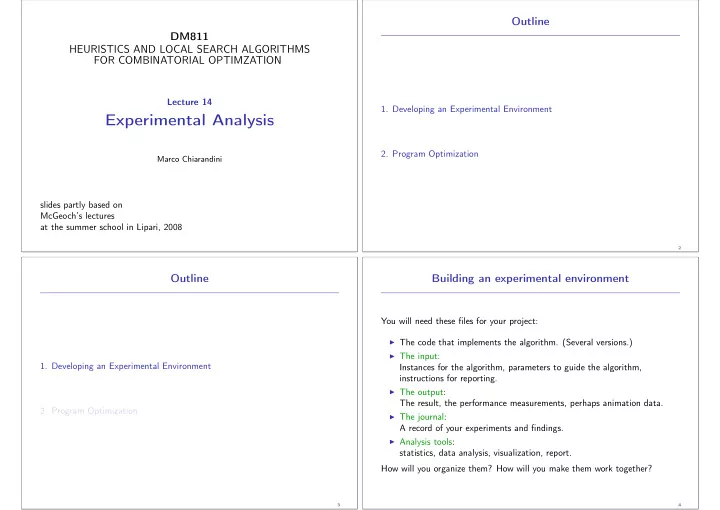

Outline DM811 HEURISTICS AND LOCAL SEARCH ALGORITHMS FOR COMBINATORIAL OPTIMZATION Lecture 14 1. Developing an Experimental Environment Experimental Analysis 2. Program Optimization Marco Chiarandini slides partly based on McGeoch’s lectures at the summer school in Lipari, 2008 2 Outline Building an experimental environment You will need these files for your project: ◮ The code that implements the algorithm. (Several versions.) ◮ The input: 1. Developing an Experimental Environment Instances for the algorithm, parameters to guide the algorithm, instructions for reporting. ◮ The output: The result, the performance measurements, perhaps animation data. 2. Program Optimization ◮ The journal: A record of your experiments and findings. ◮ Analysis tools: statistics, data analysis, visualization, report. How will you organize them? How will you make them work together? 3 4
Example Example Input and reporting controls on command line If one program that implements many heuristics mssh -i instance.in -o output.sol -l run.log > data.out ◮ re-compile for new versions but take old versions with a journal in Output on stdout self-describing archive. #stat instance.in 30 90 seed: 9897868 ◮ use command line parameters to choose among the heuristics Parameter1: 30 Parameter2: A Read instance. Time: 0.016001 ◮ C: getopt , getopt_long , opag (option parser generator) begin try 1 best 0 col 22 time 0.004000 iter 0 par_iter 0 Java: package org.apache.commons.cli best 3 col 21 time 0.004000 iter 0 par_iter 0 best 1 col 21 time 0.004000 iter 0 par_iter 0 mssh -i instance.in -o output.sol -l run.log --solver 2-opt > data.out best 0 col 21 time 0.004000 iter 1 par_iter 1 best 6 col 20 time 0.004000 iter 3 par_iter 1 best 4 col 20 time 0.004000 iter 4 par_iter 2 ◮ use identifying labels in naming file outputs best 2 col 20 time 0.004000 iter 6 par_iter 4 exit iter 7 time 1.000062 end try 1 5 6 Example Outline ◮ So far: one run per instance. Multiple runs, multiple instances and multiple algorithms ➨ unix script (eg, bash one line program, perl, php) ◮ Data analysis: Select line identifier from output file, combine, send to grasp scripts. 1. Developing an Experimental Environment Example grep #stat | cut -f 2 -d " " ◮ Data in form of matrix or data frame goes directly into R imported by 2. Program Optimization read.table() , untouched by human hands alg instance run sol time ROS le450_15a.col 3 21 0.00267 ROS le450_15b.col 3 21 0 ROS le450_15d.col 3 31 0.00267 RLF le450_15a.col 3 17 0.00533 RLF le450_15b.col 3 16 0.008 ... ◮ Visualization: Select animation commands from output file, send to animation tool. 7 8
Program Profiling Code Optimization ◮ Profile time consumption per program components ◮ under Linux: gprof 1. add flag -pg in compilation ◮ Check the correctness of your solutions many times 2. run the program 3. gprof gmon.out > a.txt ◮ Plot the development of ◮ Java VM profilers (plugin for eclipse) ◮ best visited solution quality ◮ current solution quality − Can’t control / isolate components of interest. over time and compare with other features of the algorithm. − All profilers will affect runtime. − Library function calls not shown. − Timing is not so accurate (based on interval counts), especially for quick functions. Function times rarely add up to whole. − Doesn’t work with multithreaded, multicore programs. 9 10 Where do speedups come from? Code Tuning ◮ Caution: proceed carefully! Let the optimizing compiler do its work! ◮ Expression Rules: Recode for smaller instruction counts. ◮ Loop and procedure rules: Recode to avoid loop or procedure call overhead. Where can maximum speedup be achieved? How much speedup should you expect? ◮ Hidden costs of high-level languages ◮ String comparisons in C: proportional to length of the string, not constant ◮ Object construction / de-allocation: very expensive ◮ Matrix access: row-major order � = column-major order ◮ Exploit algebraic identities 11 12
Where Speedups Come From? Relevant Literature Bentley, Writing Efficient Programs; Programming Pearls (Chapter 8 McGeoch reports conventional wisdom, based on studies in the literature. Code Tuning) ◮ Concurrency is tricky: bad -7x to good 500x Kernighan and Pike, The Practice of Programming (Chapter 7 ◮ Classic algorithms: to 1trillion and beyond Performance). ◮ Data-aware: up to 100x Shirazi, Java Performance Tuning , O’Reilly ◮ Memory-aware: up to 20x McCluskey, Thirty ways to improve the performance of your Java ◮ Algorithm tricks: up to 200x program. Manuscript and website: www.glenmcci.com/jperf ◮ Code tuning: up to 10x Randal E. Bryant e David R. O’Hallaron: Computer Systems: A ◮ Change platforms: up to 10x Programmer’s Perspective , Prentice Hall, 2003, (Chapter 5) 13 14
Recommend
More recommend